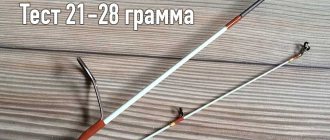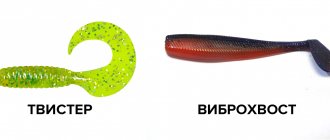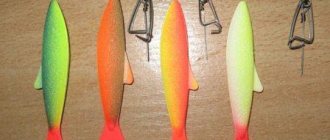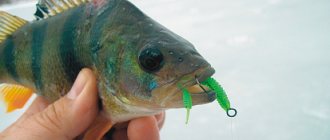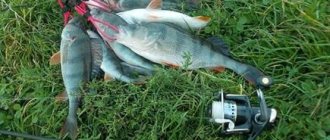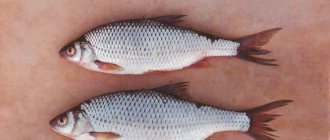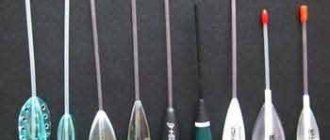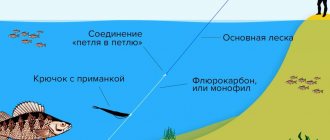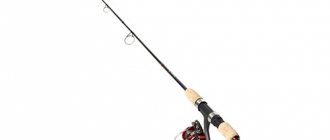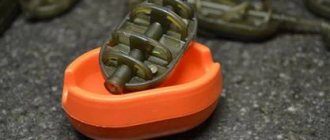Yuri 12/25/2020 423
Among the variety of fishing lures offered in abundance by specialized fishing stores, two of the most popular types can be identified - vibrotails and twisters. These effective lures went on sale around the beginning of the 2000s, and have since enjoyed steady popularity among experienced anglers. The main advantages of these baits, which have ensured that they are in such high demand among lovers of hunting predatory fish, include low cost and ease of installation. and high catch rates.
What bait is best to start with?
As for size, pike are not particularly picky about what they eat, except on hot summer days. At this time, she rarely chases prey, but is content to swim by itself. This behavior is also typical for the pre-spawning period. For such periods, it is better to use rippers no longer than 50 mm as bait.
The vibrotail for pike in the fall and spring after spawning should have a length of 70 mm. The optimal size of silicone for the time of greatest activity of this predator is considered to be 70-120 mm.
The jerk method involves small-amplitude sharp upward movements of the rod followed by release. During this process, the bait flies up to the surface of the water and then falls to the bottom.
Vertical fishing can only be used when fishing vertically from a boat. It consists of making vertical, linear movements with the rod to raise and lower the bait.
The best installation of vibrating tails
Pike can be caught well with a twister only if all the conditions for selecting bait parameters are met.
The rules for installing a silicone product in this case also occupy a worthy place among the conditions that allow you to effectively fish with a twister.
The most popular types of installation are the following:
- Fishing with jig heads.
- Free installation on a hook.
- Mounting on offset hook.
In fishing stores you can freely buy ready-made silicones already equipped with a jig head. Some models come assembled from the factory, while others are installed by the sellers themselves. Having some experience in putting baits on a hook, you can install them yourself. A vibrating tail for pike requires precise equipment, otherwise the bait will behave incorrectly in the water.
The hook of the jig head must match the size of the silicone and not exceed 1/3 of its length. They start it starting from the “mouth” of the nozzle, holding the forend at an angle of approximately 300 to the longitudinal axis of the vibrating tail. It is also necessary to control that the point of the hook passes exactly in the middle of the bait and does not come out from the side, but in the center of the back. When the jig head is equipped, the silicone is adjusted and pulled closer to the load.
To make the installation most accurately, you can first attach a hook to the vibrating tail and mark the entry and exit points of the sting, as well as the expected location of its forearm.
How to catch pike with a twister
A pike twister, while not differing in shape, differs significantly from a perch fishing tool in its size. For pike hunting, baits measuring 12–15 cm are purchased, and if you are confident that the reservoirs contain specimens weighing 5–7 kg, even a twenty-centimeter version will become an acceptable option for fishing. The silicone is toothy in nature with a ribbed body and a wide tail.
Important! Edible rubber attracts predators at any time of the year, regardless of the water temperature.
As a rule, pike attack more solidly colored silicone, which is selected based on the preferences of the predator at the time of fishing. It is worth noting that when silicone gets into a pike’s mouth, even if the outcome of the fight with the trophy is unsuccessful for the angler, it is subject to serious deformations. For pike hunting, you need to purchase several identical promising baits so that there are conditions of equal turnover, which sometimes plays a decisive role in the success of the entire fishing.
Features of installing twisters on pike
The peculiarities of installing twisters on pike differ in that anglers prefer mounting silicone baits on stationary jig heads and assembling baits in combination with articulated weights or Cheburashkas. Since pike fishing is mostly carried out in cramped conditions, snags and with the presence of aquatic vegetation near the bottom, it is convenient to use offset hooks in hinged installations, which make the bait non-snagging. When fishing in clear waters, it is justified to use sliding double hooks, which greatly increase the chances of reliably catching a pecked trophy. When using stationary weights, they try to place the hook of the jig head as close as possible to the body of the bait, thereby reducing the likelihood of hooks and picking up all kinds of plant debris that affects the quality of the retrieve and the attractiveness of the installation.
Posting bait for pike
To catch pike with a twister, you need to use a stepwise retrieve, alternating with long pauses, with passive fish reaching up to 10–12 seconds. The bait is necessarily placed on the bottom, receiving a kind of blow, which additionally attracts a predator from distant distances with its sound. The step is carried out in three or four full turns of the reel, thus obtaining a clear horizontal direction of each stroke of its stroke of 20–30 cm. The attack almost always occurs at the moment the bait stops and its free fall to the bottom, when the action of the tail reaches the main operating parameter irritating the predator.
Original models of twisters and vibrotails
Life does not stand still, and we are constantly trying to improve what we have. Soft plastics are also changing.
Improvement of twisters is carried out mainly in two directions: the use of additional elements (legs) and the use of a weight embedded in the body.
Additional legs (Fig. 4) make the bait play more voluminous; not only the tail, but also the limbs play. Although this advantage seems controversial to me - it can help when catching pike, but it is more likely to alert pike perch or perch, because the latter often “hit” the motionless body, and not the dancing tail.
Pike, like other predatory fish, is able to distinguish colors. However, this does not mean that she sees in the same way as a person. In fish, this process is somewhat different, so it is impossible to say with confidence that the color of the bait is significant.
On this issue, the opinions of fishermen differ: some argue that only the play of the bait matters, while others tend to think that its coloring plays a decisive role.
There is really no reliable data on whether fish are more attracted to the color of the bait or its behavior in the water. But you definitely shouldn’t use bait that is black, blue or green.
For fishing in spring and autumn, silicones of red and yellow colors are used. A vibrating tail for pike in summer should be white, gray or yellow with a black back. Installation of a vibrating tail for pike
However, you cannot go fishing with bait of a certain color. It is better if the angler has a whole set of multi-colored rippers of various shapes and sizes with him.
What is a twister?
Among fishing enthusiasts, this name refers to a huge selection of baits made of silicone. They have a cylindrical elongated shape with a flat crescent-shaped tail at the end. In stores you can purchase modifications of twisters that have their own play during wiring. Several years ago, manufacturers of such baits used ordinary silicone material for production. Its use provided the products with high levels of elasticity and plasticity, which is why in the water element the baits sat securely on the hooks and behaved quickly, imitating the behavior of small fish. Predators attacked them, reacting exclusively to movements, but were not always detected.
Today, edible soft rubber has come to the fore in the production of artificial baits. Its creators add amino acids, flavored salts, and various attractants to silicone. Thus, baits appear that not only actively move, but also smell attractive, without raising doubts among predators.
“Edible” also has its own drawback - unreliable strength. It doesn't last long and quickly deteriorates. To bring it out of working condition, even the grip of a perch and asp, which do not have toothy mouths, is enough. On the other hand, such baits are much more catchy, which makes up for their disadvantage, besides, silicone is a consumable material, and nothing can be done about it.
Beginner fishermen confuse twisters with vibrotails. Both baits are made from silicone, but the second shape is more like a small fish. The main difference between a vibrotail and a twister is a more mobile tail. Thanks to this design, it plays better when wired.
To learn more:
How to make a mandula with your own hands
What to choose, a twister or a vibrotail, each angler decides for himself. For pike hunting, the best option would be the second one; in water it is characterized by vibrations with low frequency and wide amplitude. Toothfish like such bait games more, since twisters create high-frequency vibrations.
They are also given an advantage in cases where long and targeted casts must be made from the shore. Their flight properties are much better than those of vibrotails. But if the fishing spots are covered with vegetation or snags, then it is advisable to choose a twister with a bait that catches less. In any case, every spinner should have new twisters and vibrotails that have been in “battles”.
Jig head for equipping a vibrating tail and twisters
spherical solid; Eri head; articulated.
The first type of jig heads is the most common and popular. Their design consists of a single hook with a long shank with a ball-shaped weight soldered onto it. A silicone equipped with such a head is the best vibrating tail for pike in reservoirs with standing water or weak currents. The best vibrating tail for pike
The Eri head is different in that the load is separated from the hook by a carabiner and brought forward. This allows it to move independently of the silicone. It sinks to the bottom very quickly and becomes vertical. Used for fishing in strong currents.
An articulated jig head is similar to a regular ball jig head, but has a movable weight that moves vertically relative to the forearm. Gives excellent results with stepwise fishing, when the bait moves from the bottom to the surface and back.
Source: sezonribalki.ru
1.History and general description of silicone bait
The American company Mister Twister for the first time in 1972 revolutionized the fishing world of lures by producing a miracle bait called “curly tail,” which translated meant “curly tail.” An inconspicuous, at first glance, tail, made of dense silicone, was the ancestor of future silicone lures. In the 80s it became widespread and recognized in Europe. The fishing innovation came to Russia only in the 90s.
Silicone twister bait, as Russian fishermen nicknamed it, is a derivative of the English word twist, which means “curl” and grubs “larva” sounds in English as twister tail grub.
Fishing with silicone twister baits is a dynamic and exciting activity. This type of rubber is one of the active baits, since at a slow pace of retrieval its play is expressive.
Area of use of silicone lure:
- classic jig;
- leash equipment for spinning rods (with-out leash, drop-shot, split-shot, Carolina and Texas rigs, used as an addition to spinners).
You can read more about jig fishing here
Types of silicone baits. Review
Date: February 8, 2015 | 211
The popularity of silicone lures for jig spinning is growing continuously. The topic is developing, and it is not surprising that the variety of baits of this type is also increasing. Silicone is produced by many companies in dozens, if not hundreds, of forms that can be categorized into specific types. I want to briefly talk about these types, types and main forms of silicone baits and edibles now in the form of a quick review. Each class deserves detailed consideration, a thorough analysis of its capabilities and features. So, each class will have its own separate article. And now - a preliminary acquaintance with the entire family of silicone baits.
The entire silicone family began with plastic fish. When a softer material, silicone, began to be used, the first two main forms of baits were developed: vibrotails and twisters. With the advent of edibles, the so-called. edible silicone impregnated with attractants and various additives, the range of forms has expanded: slugs, fish, worms, crayfish, octopuses, cuttlefish, hybrids. Most of the forms were not created out of the blue, but are prototypes of real fish food: worms, crustaceans, leeches, fry, etc.
Vibrotails . One of the basic forms of silicone, from which it all began, is vibrotail. General characteristics by which a vibrating tail can be distinguished by the presence of a penny tail, which is designed to carry out vibration.
The body shape of the vibrotail can be different. There are vibrotails with a narrow body, with a tall body, with a round body, etc. The tail-penny can be massive or not very massive, which determines the frequency of vibrations produced by it. The tail may have a notch for better, more lively play, or it may simply be tapered, without notches.
Today, the use of vibrating tails made of ordinary silicone is also relevant in the edible class. If ordinary vibrotails are more conservative, as a rule, they use two main forms: narrow-bodied (minnow) and tall-bodied (shad), then in the case of the edible, the variety of forms is much wider. In addition to the classical forms, the bodies and tails of edible vibrotails are subject to various variations. There are segmented bodies, concentric rings throughout the body, and intricately shaped transitions to the tail.
The sizes of vibrotails vary, from 1.5 inches to 5-6”. The softness of silicone may vary. There are a lot of color options. It is recommended to equip vibrotails on jig heads. Only small vibrating tails of the microjig class are sometimes equipped with a hinged mounting. Vibrotail is one of the most effective baits for catching predators, because... imitates a fry whose small fish a predator feeds on.
Twisters . The second basic form of silicone baits is a twister. The body of a classic twister resembles a kind of larva on which a thin sickle-shaped tail is installed. In addition to the usual twister body shape, other variations are possible: elongated worm-shaped, fish-shaped, etc.
A twister may have a more or less corrugated body. There may be some appendages on the body, imitations of paws. It is difficult to say what a twister imitates, because... there is no direct analogue. At the same time, the fish, perceiving the vibration and seeing the object, takes the bait for some living creature, insect, etc.
There are twisters with double tails. It is believed that the double-tailed twister is an imitation of a toad, a frog that works with its hind legs.
In the water, the twister actively plays with its tail, creating high-frequency vibrations that attract fish. They are equipped with twisters, both on jig heads and on a hinge, as well as offset hooks. In terms of their effectiveness, the twister, along with the vibrotail, continue to be the most catchy soft baits, despite the expansion of the range of them.
Slugs . One of the popular forms of passive silicone. If classic soft baits, twisters and vibrotails are active silicone, then slugs are passive. This bait does not have its own game when retrieved evenly; it needs to be set in motion by changing the reel speed of the reel and manipulating the tip of the spinning rod.
Slugs can be distinguished by their tail, which tapers relative to the body. The body can imitate a fish, be similar to the body of a classic vibrotail, only there is no penny on the tail, but just a thin straight tail, or a forked tail, like a fish’s. Also, the body of a slug can resemble a worm or a leech and have pronounced concentric rings.
Slugs are used in various installations and equipment. The slug can be mounted on a hinged mounting with a single or offset hook. Also, these baits are widely used in Texas rigs, drop-shots, and retractable leashes. You can use slugs with an offset hook, without weight, for fishing in shallows and in the grass.
I animate slugs using waves, jumps, vibration, dragging, and a classic step. Medium and large slugs are successfully used for catching zander and pike. Perch and various peaceful fish are successfully caught using small slugs. Almost all slugs are made from soft silicone, which has edible properties and is impregnated with an attractant.
Fish . Fish are an intermediate class between vibrotails and slugs. This is usually passive silicone. The main trend is the imitation of a small fish, a fry. Often, they try to get as close to maximum realism as possible, to make the bait exactly like a fry, to make it a natural color, translucent, with clearly defined eyes, gills, scales and a forked tail. However, this is not necessary. There are fish that are also conditionally similar to the living prototype, like vibrotails.
Fish are equipped with hinged mounts, offset hooks with or without weights. Silicone fish are often used when fishing with a drop shot and a retractable leash. Because These baits, for the most part, do not have their own game; they are animated with the tip of a spinning rod, as usual, passive silicone, trying to reproduce the movement of a fish or fry in the water. They use both smooth wave-like movements and rather sharp tosses.
Worms . Silicone worms are a very popular and effective soft bait for microjigging and other spinning styles (lead line, drop shot, Carolina rig, etc.). It is clear that fish are very fond of various worms and larvae. This is clearly evidenced by the experience of fishing with a float rod and a feeder. The developers reasoned quite logically. What if you make a bait in the shape of a worm, from very soft silicone, giving it a smell and taste attractive to fish. And so it happened and a whole galaxy of baits appeared that imitated worms, leeches, and bloodworms.
The shape may directly resemble a worm, or have some deviations, in the form of a deep ring-shaped notch or variable thickness, bringing the worms closer to the slugs. Often, it is difficult to say, for example, such a famous bait as Tsunekichi Worm and its clones are worms or slugs... Something in between.
Silicone worms are a passive bait that needs to be revived using a spinning rod. Worms are equipped with single or offset hooks, mounted hingedly with a light weight Cheburashka weight, or on a lead leash, split shot, or Carolina rig. This style of installation, such as “weki”, is most applicable with silicone worms. Large silicone worms are used to successfully catch pike, pike perch, catfish, and large peaceful fish. On small ones, mainly perch, as well as by-catch, a full range of peaceful inhabitants of the reservoir, because The worm is a universal food for fish. And the artificial silicone imitation does an excellent job of deception.
Cancers . Crayfish and crustaceans are a favorite food for a variety of predatory fish, as well as large peaceful fish. The creation of silicone imitations of these organisms is quite understandable. Their high efficiency is not surprising either. The fish sees a crustacean moving near the bottom and mistakes it for its usual food, because... he behaves attractively, smells good, and tastes just right. But it turns out that this is a hoax.
Silicone crustaceans are produced in a wide variety of shapes. Some very closely repeat the shape of their living prototypes, others very distantly. One way or another, crustaceans catch perch of different sizes very well. They catch pike, pike perch, and large peaceful fish. This is a great bait.
Silicone crayfish are a passive bait in most cases. They equip it freely, on a hinge, to give greater mobility in the game. The crustacean is carried out by jumping along the bottom, or by dragging, or by small trembling in one place.
Octopuses, tubes . In use are not only prototypes of the usual fish food in our reservoirs, but also very controversial baits, for example, imitations of squid, octopuses and other sea creatures that our fish have never seen in their lives. However, as proof of the conventionality of bait forms, silicone tubes or octopuses, as they are called, work great.
These are also passive baits. When playing with the tip of a spinning rod, the fringe of their tentacles and limbs flutters very temptingly. And the fish are caught on this, and they are caught very well. Perch and pike perch bite on such baits, and pike also jump through. With small variations of these baits, a wide variety of peaceful fish are caught quite well.
Cuttlefish. Hybrids . Nymphs . Continuing the topic of silicone baits, which have no prototypes among real living organisms in our freshwater bodies, one cannot fail to mention the class of various cuttlefish. It is not clear what these baits are like for fish, but they respond excellently to their play.
Also, next to cuttlefish, you should consider a variety of unusually shaped baits that are difficult to attribute to any specific class described above. Either they combine several elements of these baits at once, or they have elements that are not quite typical. One way or another, it’s worth trying to catch them. After all, fishing is about experimentation. When the classics fail, you can find success by using non-standard baits and methods of presenting them.
This is what a great variety of modern silicone baits look like. In future articles I will consider in more detail each of the mentioned classes, as well as review specific models of silicone and the features of its application.
Share with your friends:
Categories: Edible · Tags: Jig, Lures, Silicone
The difference between a twister and a vibrotail
Twister Feature:
- unlike its brother - high frequency of tail oscillations at the slowest retrieve rate;
- large amplitude of oscillations of the tail part due to its wide design, in contrast to the vibrating tail, the frequency of oscillations of the heel is lower;
- has a good casting range, which makes fishing from the shore an advantage;
- passes well through areas with vegetation and snags;
- imitates crustaceans, cephalopods and other mammals;
- used as an addition to the main nozzle.
A short video of the twister in action
How does a twister differ from a vibrotail?
The concept of silicone fish is closely related to two types of equally common and equally popular silicone bait. Beginning spinning anglers must clearly perceive the differences between twisters and vibrotails, which is sometimes not immediately possible for some anglers who are not particularly attentive.
The vibrotail differs from the bait we are considering in the shape of its body and the structure of the working element, or rather, the tail. The body of the vibrotail is slanted, with a noticeable narrowing towards the tail, which is much shorter than the body of the bait and is shaped like a horse’s hoof, and this slang name can often be heard among spinning anglers and fans of fishing with silicone baits. The vibrotail is more similar to a natural fish, working only with its tail when fishing. This type of attachment is not as dynamic in movement as a twister and requires certain skills from the fisherman when performing animation.
Twister characteristics
3.1 Form
The structure of a twister resembles a worm. The tail is flat and consists of a long, rounded tail. Rings are carved along the length of the abdomen; in some models other elements may be provided. The peculiarity of such an ornate body is its ability to be mobile under any fishing conditions, and if equipped with a floating head and a firefly, then you can fish on the surface of a reservoir, in muddy water and at any depth. Many people use this bait as an additional element to spinners (oscillating or rotating).
The shapes of twisters are varied: wide and narrow, ribbed and smooth, two-tailed, short and long. The play and behavior of this rubber depends solely on the shape of the tail and the softness of the material.
3.2 Material
Twister can be made of soft plastic and various polymer materials. The most common and desired material is silicone, and each manufacturer uses its own secret recipe when making baits.
3.3 Size
Size range – from 1 to 30 cm.
What sizes and what to use:
- Microjig - size 1 - 2 inches;
- Trolling + heavy jig heads - from 4 inches.
- Large sizes for catching saltwater fish and catfish in freshwater bodies.
Average size tires are considered to be 2.5 - 4 inches.
Below is a table for converting inches to centimeters
When choosing a size, you should be guided by the following:
- determine the type of desired production;
- resolve the issue of casting range;
- determine the strength of the current.
Based on these characteristics, the necessary size selection is made for a specific fishing trip.
3.4 Color of silicone lures
Conditions for choosing the color of silicone baits:
- water condition of the reservoir;
- seasonality;
- time of day of fishing;
- weather.
What colors to use and under what conditions:
- muddy water - bright colors;
- cold and clear water – from blue to purple;
- clear water – calm (natural) shades (green, milky with white, transparent brown);
- clear water and sun - bright colors;
- muddy water and bright day - bright baits, for example pink;
- cloudy days – black, blue, red colors.
The yellow color of silicone baits, according to many anglers, is considered universal in the color scheme of twisters. Do not forget that the choice in favor of one shade or another is made by the fisherman experimentally.
Types of marine fish and colors:
- perch – black and brown colors;
- cod – black and brown colors;
- sea bass – white, gray colors;
- squirrel fish - dark colors;
- barracuda - dark shades.
Do you want to see how the color of silicone baits changes underwater? Then watch this fascinating video (Fishing PRO)
Twisters for perch and striped fishing techniques
Fishing for perch with a twister can be carried out both in bodies of water with a current and in still water areas. This relatively small predator lives in packs. If on rivers striped sites can be found at the borders of contact between strong currents and relatively calm water, then in standing waters perches love snags on the bottom, junctions of clear water with thickets and all sorts of bottom anomalies, hiding behind which they calmly lie in wait for a passing victim. You can use a twister for perch throughout the entire period of open water, and we will talk about the nuances of selecting a perch bait in the following sections of the article.
Selection of bait by color and smell
Perch prefers baits in contrasting zonal colors.
Important! The practice of perch fishing has noticed that the presence of red color has the ability to improve the bite regardless of the time of year and the intensity of illumination of the reservoir.
The point of attack in the form of the red head of the silicone or its tail against the background of a white, light green, yellow and brown base brings the most significant fishing results. At depths, lures of a light green-acid color work; compared to other colors, they are much more noticeable in dark water and their color spectrum is not distorted compared to the yellow, red and blue colors, which become much dimmer at depths of more than three meters than in light. Twister fishing in the fall is much more successful with the use of edible rubber with the smell of fish oil and interspersed with glitter, shimmering with rainbow tints.
How to install a twister when fishing for perch
Spaced mounting of the bait is considered pure perch fishing. The retractable leash and the drop-shot method are especially productive. For perch hunting, silicones are selected in sizes of three to five centimeters, which are installed 30 cm from the sinker, and therefore the bottom of the reservoir. The dregs from the load stretching along the bottom arouses the initial interest of the predator, which, upon approach, noticing the silicone, attacks the bait. Under some fishing conditions, it is possible to use several baits simultaneously, installed in different water levels for a more efficient search for fish sites.
Posting bait and its methods when catching perch
The method of guiding the twister depends on the activity of the fish, the strength of the current and the bottom topography. An active perch reacts to sharp and fast movements. Passive fish require slowdowns and pauses during regular movements. Stepped fishing is used to catch fish at depth differences and exits from pits. This technique is also effective when fishing the bottom with a distinct profile of multi-level relief, where smooth plateaus alternate with holes and ledges in the bottom base.
Uniform movements are more effective on a flat bottom, on sandbanks and when fishing in snags. Also, using a uniform retrieve, the boundaries of thicket banks and smooth ascents from the riverbed on sandy river spits are fished.
What kind of sea fish are caught with silicone baits?
By experimenting with different colors and using large-sized twisters, you can catch the following sea creatures:
- grouper;
- Farida;
- bluefish;
- garfish;
- television;
- sea bass;
- barracuda;
- squirrel fish;
- sea bass;
- cod;
- sea dragon;
- dorado fish;
For lovers of fishing in sea waters, we suggest that you familiarize yourself with detailed information about the Mediterranean Sea, its weather conditions, relief, water temperature, water currents and inhabitants - Mediterranean Sea: description, history, interesting facts
Twister wiring technique
There are two types of twister wiring:
- uniform;
- stepped.
In the first option, spinning wiring is performed mainly on:
- shallow water;
- smooth, textured bottom surface.
The speed limit is selected according to the nature of the specific production. So, a passive predator needs to be teased with calm and uniform wiring. Active fish will easily bite when moving in steps with increasing speed. This fishing technique is suitable for special places with holes and depressions, edges, and drops. If fishing takes place in the cold season, then it is better to move the twister smoothly.
Read more about jig fishing, its features, and options for wiring techniques here
How to choose a silicone twister bait
Tips for choosing quality bait:
- When purchasing, you should pay attention to the tail of the bait and its size; it should be solid, smooth and without unnecessary notches.
- Carefully examine the shape of the body, which should not bubble or have other defects.
- The material from which the bait is made must be plastic and soft, since the better these qualities are, the better the playing behavior of the bait.
- Pay attention to the fact that the belly and tail of the rubber should be uniform and without excess connective tissue.
- Try the bait for stretchability, as high-quality material stretches well.
We choose catchy colors of vibrotail and twister. Is the color of the bait important?
Pike, like other predatory fish, is able to distinguish colors. However, this does not mean that she sees in the same way as a person. In fish, this process is somewhat different, so it is impossible to say with confidence that the color of the bait is significant.
On this issue, the opinions of fishermen differ: some argue that only the play of the bait matters, while others tend to think that its coloring plays a decisive role.
There is really no reliable data on whether fish are more attracted to the color of the bait or its behavior in the water. But you definitely shouldn’t use bait that is black, blue or green.
For fishing in spring and autumn, silicones of red and yellow colors are used. A vibrating tail for pike in summer should be white, gray or yellow with a black back. Installation of a vibrating tail for pike
However, you cannot go fishing with bait of a certain color. It is better if the angler has a whole set of multi-colored rippers of various shapes and sizes with him.
Vibrating tail for pike: 10 best jig baits
Specialized fishing stores today offer a wide range of spinning lures, among which silicone baits receive special attention. After their appearance on the market, they quickly became popular among fans of so-called predatory fishing due to their low cost, maximum ease of use, and excellent catchability. Today we will try to cover the topic - vibrating tail for pike: 10 best jig baits.
Classification
There are two main types of silicone baits on the market today:
- twisters;
- vibrotails (another name is rippers).
These species are not equipped with their own loading and are used for mounting on an offset hook or jig head.
Twister has the shape of a worm with a ribbed texture and a wide, spiral-shaped tail. During movement, the tail, under the influence of the flow of water, changes shape, vibrates, and straightens. Due to this, the attention of predators is attracted.
The vibrotail is a silicone dynamic attachment in the shape of a small fish. The main element of such a nozzle is the tail. The bait resembles a hoe in appearance. In this case, the tail part of the vibrating tail is made in the form of a short blade located at a right angle relative to the “body” of the nozzle. When inserted, the nozzle resists the flow of water and spins in all directions at different frequencies, which in appearance is very similar to the movement of an ordinary fish.
Classification of vibrotails
The main criteria for the classification of rippers are the geometric parameters and dimensions, according to which the nozzles are divided into:
- narrow nozzles “long” - made in an elongated narrow shape with “cuts” at the beginning of the tail section. This nozzle is effective not only due to the soft material, but also to its special “cut” shape. The tail seems to be separated from the main body and connected to it only by thin silicone. Due to this, the tail of the nozzle plays freely under the influence of water currents.
- nozzles with a wide body shape. These types are usually made of soft silicone in order to provide better elasticity and, consequently, range of motion. These baits are effective when catching pike in overgrown reservoirs. As a rule, such baits are made in the form of tasty morsels of predators - bleak, roach, chub.
- narrow nozzles without cuts - are made of harder silicone and are used mainly in fast flows.
Separately, we can highlight models of rippers in which a weight is built in. They are made of dense material - rubber or silicone, and in appearance they strongly resemble a wobbler. Such baits attract the attention of predators by being painted in colors similar to those of common fish.
Rules for choosing a vibrating tail for pike
Pike is an amazing predatory fish that almost does not use its own sense of smell when hunting. She is interested in color, movement, and size of potential prey. For this reason, when choosing the optimal vibrating tail, you should take into account the following characteristics of the nozzle:
- color;
- shape and size;
- performance of the tail section;
- rigging method.
Color
The color criterion when choosing bait involves taking into account the time of year, climatic conditions and the specifics of the fishing location.
So, in spring and autumn it is recommended to give preference to natural colors. Small spots of bright colors are allowed. In summer it is better to use baits of bright colors.
In light water, it is better to choose dark colors that predators can easily detect. When the water is cloudy, you should choose light and bright models, which are easier to notice in specific conditions. If the pike is overly active and ready to attack any bait, then natural colors are a good choice. In opposite conditions, it is better to use “irritating” colors - acidic, bright.
Shape and size
Narrowed options are much more effective in strong current conditions. They play more consistently, and when casting they fly much further, more accurately. Wide models are characterized by greater intensity of play in the absence of current.
If there is no narrow vibrating tail, then you can cut off the abdominal part of a wide model, making a more optimal option.
Bites are directly determined by the degree of mobility of the tail part and its shape. Intense play is made possible thanks to the small blades. Large blades, on the contrary, make it possible to carry out low-frequency, but more powerful playing. In some models, notches are made on the tail section to increase the intensity of movement. Tail mobility can be assessed as follows. To do this, the bait rises up from its rear. If the blades oscillate approximately identically in both directions, then this model will play steadily even in conditions of slow wiring.
Vibration tail installation options
The success of fishing is largely determined by the quality of the bait installation. Just one mistake will reduce your fishing results to zero. For example, the bait will not be able to play due to improper installation, which will cause the predator to lose interest in it. Today there are several known methods of attaching vibrating tails to a hook, which allow the bait to fully open and achieve the desired result:
- Using a hard lead jig head with a hook. This method is considered the most accessible and easiest to implement. The main thing is to ensure the correct size ratio of the jig head and bait. It is necessary to ensure that the sting protrudes from the dorsal fin, which makes subsequent attachment possible. The disadvantages of such equipment include the fact that in order to adjust the weight it will be necessary to bait it on another hook, which contributes to faster wear of the vibrating tail.
- Flexible installation using a sinker - Cheburashka. This method is quite popular today among fishing fans, since it involves fewer different kinds of difficulties. Thus, the hook is selected once, and the sinker is easily replaced using a special winding ring. The advantage of this method is that the bait does not get caught when using an offset tool, when there is no need to pull the tip out. Due to this, you can fish even in overgrown and snag-ridden reservoirs.
- Movable installation. This method makes it possible to easily replace hooks. Doubles and tees are effective when used in clean areas free of snags and algae. If the bait is longer than the hook, you can connect a tee or double to a ring using a wire extension.
The best vibrotails for pike fishing
Vibrating tails have become especially rapidly gaining popularity in recent years. These rigs were able to take leading positions in the unofficial ranking of preferences, replacing wobblers and twisters. At the same time, we can already talk about a certain list of models of vibrating tails, which are especially in demand among fishermen due to their high performance characteristics.
10 best models for pike fishing
- "Crazy Fish" "Vibro Fat". This bait is produced by a domestic company and is aimed at catching predators in our reservoirs with all their features. The bait has proven itself to be excellent when catching pike, catfish, and pike perch. Convenience of equipment is ensured, among other things, by small cutouts on the body. The body has holes made for inserting nails into them. The specific shape and large tail allow for intense, interesting play that actively attracts the attention of fish.
- "Relax Kopyto". The bait has an elongated body shape with a pronounced abdominal part. The tail fin is very mobile, which ensures active play even in calm water conditions and slow retrieves.
- "Vibro Worm 3.4" is one of the largest models that demonstrates effective results. It can be combined with almost any wiring due to the start of the game immediately after getting into the water. The vibrating tail is made of plastic, soft material, due to which it plays almost always. The bait contains amino acids, proteins, the smell of garlic and seafood, which makes it attractive to predatory inhabitants of water bodies.
- "Fox Rage Fork Tail". Made from grainy silicone, which automatically makes it very realistic. The specific shape and increased plasticity make it possible to effectively attract the attention of predators and provoke an attack. When played correctly, the tail begins to vibrate quite strongly.
- "Mann's predator". It plays very actively due to the presence of a large fin in the tail. The bait can be used in almost any body of water, and its advantages include ease of installation and excellent catchability.
- "Mr.Greedy." This bait is edible, and its body has a horizontally flattened shape. This bait has a large fin, due to which active play is possible. A small incision is made on the body, where the offset machine is built in. The developers focused on the bait’s non-sticking nature, so it can be used in reservoirs with a large amount of algae and karga.
- "Mann's samba" is a small vibrating tail with indentations on the body. Active play with a significant amplitude of oscillations is possible thanks to the wide tail.
- "Spirit" In appearance, this bait resembles a small fish. The wavy fin provides an interesting game that will be felt by predators even at a great distance. The bait performs well both in calm water and in strong current conditions.
- “Rock Vib Shad” - this type of bait behaves well in strong currents and is capable of catching not only pike, but also other large predators. A high vibration frequency is possible due to the specific shape of the body.
- "Kosadaka Vibra". The model is considered universal in use due to its good results in any conditions, including climatic conditions.
Vibrotail in autumn
Pike becomes especially active when the first cold weather sets in. During this period of predators, move from shallow water to deeper areas following the real bait. Even with a large number of fry, the pike wants to try something else. In autumn, it is recommended to fish in calm water along the shore, and it is better to use white and yellow rippers with a dark back. It is better to determine the size of such baits at 6 - 8 cm. In the spring, when the amount of natural bait increases, you can use a ripper up to 10 cm, and in the summer, on the contrary, it is recommended to give preference to smaller models.
moya-rybalka.ru
The optimal size of a vibrating tail for pike fishing
As for size, pike are not particularly picky about what they eat, except on hot summer days. At this time, she rarely chases prey, but is content to swim by itself. This behavior is also typical for the pre-spawning period. For such periods, it is better to use rippers no longer than 50 mm as bait.
The vibrotail for pike in the fall and spring after spawning should have a length of 70 mm. The optimal size of silicone for the time of greatest activity of this predator is considered to be 70-120 mm.
Jig head for equipping a vibrating tail and twisters
In order for the bait to have good balance when retrieved and resemble a live fish as much as possible, you need to choose the right jig head. There are three main types of heads:
spherical solid; Eri head; articulated.
The first type of jig heads is the most common and popular. Their design consists of a single hook with a long shank with a ball-shaped weight soldered onto it. A silicone equipped with such a head is the best vibrating tail for pike in reservoirs with standing water or weak currents. The best vibrating tail for pike
The Eri head is different in that the load is separated from the hook by a carabiner and brought forward. This allows it to move independently of the silicone. It sinks to the bottom very quickly and becomes vertical. Used for fishing in strong currents.
An articulated jig head is similar to a regular ball jig head, but has a movable weight that moves vertically relative to the forearm. Gives excellent results with stepwise fishing, when the bait moves from the bottom to the surface and back.
Twisters for pike: what they are and how to use them
In the 70s of the last century, a new type of bait burst into the market and into the lives of fishermen - twisters. During this rather short period of time, they took pride of place among the most catchy baits for spinning fishermen.
With the help of twisters you can catch many types of predatory fish, including pike. Most importantly, this underwater pirate does not ignore the correctly selected and mounted “elastic band” on the tackle.
What is a twister?
Twister is an artificial fishing bait with an active and tempting game. It should not be confused with the vibrotail. Unlike the latter, the twister is less similar in appearance to a small fish, but this is not its drawback. The tail of this type of bait can be compared to a question mark or a sickle, as it has a rounded shape. It is also larger in size than the vibrotail.
Polymer materials such as soft plastic, silicone, etc. are used as raw materials for the manufacture of twisters. Product sizes vary from 1 to 30 cm. Large “rubber bands” are used for catching sea fish.
Twisters are used for spinning fishing for many types of predatory fish. Methods of installation on the tackle can be different, and depending on the type of fishing, the characteristics of the reservoir, as well as the desired prey, one or another installation is used.
In addition to twisters, vibrating tails are effectively used in fishing. The difference between them is in the form.
Vibrating tails are similar in appearance to fish, while classic twisters are a ribbed bait in the shape of a cylinder.
In terms of popularity, these two types of attachments are approximately on the same level.
They were invented in the 70s of the XX century. Mister Twister was the first to launch production. Now the number of brands producing these baits has increased, and in fishing stores the number of different types is simply off the charts.
The popularity of silicones was influenced by a number of their positive qualities. These include:
- Softness and elasticity. Thanks to this quality, the predator being hunted does not feel the catch. Twisters are very similar to living creatures that predatory fish choose for their food.
- Active game. Attracts potential prey.
- Availability. The prices for twisters are pleasing to the eye, thanks to which an angler with any financial condition can afford to purchase a couple of dozen baits of different colors and sizes.
- Installation. The elastic can be mounted on the tackle in several ways, each of which is better suited than others for fishing in specific conditions.
- Fishing depth. Using a twister, a spinning player can perform wiring in any layer of the water column.
- Overcoming obstacles. When installing a non-snacking option, the bait successfully avoids all underwater obstacles, such as vegetation, snags, stones, etc.
Twisters are used for fishing for catfish, perch, pike perch, asp, trout, pike and other predators. The main thing is to choose the right bait for a specific type of fish and serve it.
Selection of bait and installation rules
In order for twisters for pike to give good results in the form of many trophy specimens, you should familiarize yourself with the criteria for their selection. They differ from those that must be observed when purchasing bait for pike perch or pike perch, so it is not advisable to use the same products for all these types of predatory fish.
When purchasing, the first thing you need to consider is the size. Twisters, which can be used to catch large pike perch or pike perch, are not suitable for catching trophy pike. Only small individuals, which will be significantly smaller than the perciform representatives of the ichthyofauna, can pay attention to products of this size. To catch a large pike, you need to use rubber bands no less than 10-15 cm long.
The bait should be wide in the tail so that during the retrieve it creates an attractive game for the predator. It is also desirable to have holes in the tail, which provoke the formation of turbulence and sounds that attract pike.
It is also worth remembering that the size of the fish living in it depends on the size of the reservoir being fished. Consequently, the sizes of suitable baits also differ.
As for color, it is very difficult to establish what pike prefers in a particular reservoir and at a certain time, because its tastes can change several times during the day. Therefore, it is better not to choose any specific colors and take as many baits with different colors as possible.
Despite this, there are colors that attract predators better than others, which must be in the fisherman’s arsenal. These include golden and silver shades, as well as the color of “motor oil”.
It is also not worth looking for a suitable smell, since pike does not particularly rely on its sense of smell. A larger role than the smell in the attractiveness of the nozzle is its appearance. Therefore, you can use products with or without scent. Among all the tastes, pike prefers the meat and blood of fish.
After purchasing a twister, you need to choose the method of installing it on the tackle from the most popular options:
- rigid mounting on a jig head;
- free installation;
- non-snagging bait.
Rigid mounting is carried out on a jig head, which is cast assembled with a hook. This method has a significant drawback. It is not possible to change the weight of the bait without changing the head, so when changing fishing conditions you will have to remove the twister and bait it on a different hook, which will not have a very good effect on its service life.
The weight of the jig head should be selected depending on the reservoir.
If you plan to fish on rivers with fast currents, you need to take a sinker weighing at least 25 grams. If there is little or no current, a lighter weight can be used.
The main condition for free installation of the bait is the use of a hook with a long shank. This is necessary to bring the sting closer to the tail. Since fairly long elastic bands are used for catching pike, they are pierced with a hook at the base and pulled out in the middle. In the event that a double rather than a single hook is used, then it is inserted in the middle part of the bait and removed at the base. After installing the twister, the hook is attached to the sinker.
When installing the non-hook, the tip of the hook is hidden in the body of the twister. This allows the gear to pass through underwater vegetation and other obstacles.
Preparation of gear and fishing technique
Properly prepared gear will definitely bring success during fishing. Otherwise, you can leave fishing without a single tail at all.
The rod must be strong and of sufficient length depending on the fishing location. If it is carried out from the shore, a form 3 m long is suitable. When fishing from a watercraft, a spinning rod of a shorter length is suitable. When fishing with a heavy load, you should use a rod with a test weight of 20 to 50 g. If you will not use a sinker, you can use an ultralight rod.
A power spinning reel with a size of 4000-5000 is suitable. The spool should hold 100 meters of fishing line with a diameter of 0.4-0.5 mm.
The fishing line is selected depending on the size of the fish that you plan to catch. If a fisherman sets a goal to catch a trophy fish, he needs to use a fishing line with a diameter of at least 0.4 mm.
It is necessary to have good quality hooks. They must be made of stainless steel. In this case, if the sting peeks out from the body of the bait, its shine will not scare off the predator.
An element that should definitely be in the design of the tackle is a metal leash. Failure to do so will result in loss of the attachment. The powerful jaws and knife-sharp teeth of the predator will not leave the fishing line a single chance. You can purchase a leash in a store or make it yourself at home if you have an unnecessary guitar string.
When the gear is arranged and the equipment is selected, you can move out onto the pond and start fishing.
If the twister was mounted on a jig head, step wiring should be performed. It is also performed when the bottom has multiple relief obstacles. To do this, you need to throw the tackle into the water and wait until it touches the bottom. After this, 2-4 turns of the coil are made, and a pause follows. When winding, the twister rises, and during a pause it drops to the bottom. Usually the pike bites when the bait moves down.
When using a twister without a load, slow, even wiring is performed. During its hunt, a pike waits in ambush for its prey. A slowly moving bait will definitely attract its attention and the predator will attack.
When biting, it is important not to rush with the hook, since the hunter first clamps the prey in her jaws, and then turns it around to swallow it. If you hook at this moment, the twister will simply fly out of the mouth, and the fisherman will be left without a trophy.
If you follow all the recommendations, the fisherman will definitely pull several trophies out of the water.
Let us know about it - rate Loading...
tvoyarybalka.ru
The best installation of vibrating tails
In fishing stores you can freely buy ready-made silicones already equipped with a jig head. Some models come assembled from the factory, while others are installed by the sellers themselves. Having some experience in putting baits on a hook, you can install them yourself. A vibrating tail for pike requires precise equipment, otherwise the bait will behave incorrectly in the water.
The hook of the jig head must match the size of the silicone and not exceed 1/3 of its length. They start it starting from the “mouth” of the nozzle, holding the forend at an angle of approximately 300 to the longitudinal axis of the vibrating tail. It is also necessary to control that the point of the hook passes exactly in the middle of the bait and does not come out from the side, but in the center of the back. When the jig head is equipped, the silicone is adjusted and pulled closer to the load.
To make the installation most accurately, you can first attach a hook to the vibrating tail and mark the entry and exit points of the sting, as well as the expected location of its forearm.
Technologies and methods of twister installation
There are several successful ways to attach such a bait to create catchy fishing gear. The most popular are:
- installation based on a jig head;
- spaced twister rigs;
- non-snacking lure mounts;
- hinged mounting method.
The technique of spaced rigs is that the weight and the bait must be moved away from each other. In this case, the silicone gets more free space and allows the person with the rod to perform measured, slow retrieves.
When fishing in more difficult conditions, you need to choose equipment that does not get caught on obstacles. With this type of installation, you can confidently fish rocky areas of the bottom, snags, and reservoirs with abundant vegetation. It is better to attach the nozzle in tandem with an offset hook, then it can easily pass through difficult places. With such equipment, the tip is hidden in silicone, and with a successful bite it is released and dug into the predator’s mouth.
To properly attach a twister attachment to an offset hook, you need to select an offset of the required length. Then pierce the bait through the “mouth” from the head and bring the tip out into the “neck” area. The twister is pulled to the bend and smoothly brought to the eye. Having unrolled the hook, carefully fold the body of the bait and sharply pierce it. The sting is brought out at the top of the nozzle and “sunk” in silicone. At the last stage, the bait with a sharp offset hook is attached to a sinker of the required weight.
To learn more:
10 best wobblers for trout on paid sites
The most popular (even beginners and novice spinning anglers can handle it) way of mounting twisters is to mount them on a jig head - the bait is placed on a hook rigidly fixed in a weight. Twister jig heads come in the shape of a bullet, horseshoe, fish head, and boot. The most common are spherical. Such equipment is not difficult and provides the structure with the necessary rigidity of the connection.
The technology of hinged combination is that the twister is adapted to a single (you can use a double, triple - as you like) hook and attached to a weight called a “Cheburashka”. This fastening gives the bait a high level of freedom, allowing you to cast it to a maximum distance. The twister is attached to the weight with a clasp or winding ring. The disadvantage of this method is the possible overlap through the leash. In this case, the wiring will be less effective. To avoid unnecessary misfire, before inserting the twister, you need to slow down the slippery line by touching the spool with your fingers.
